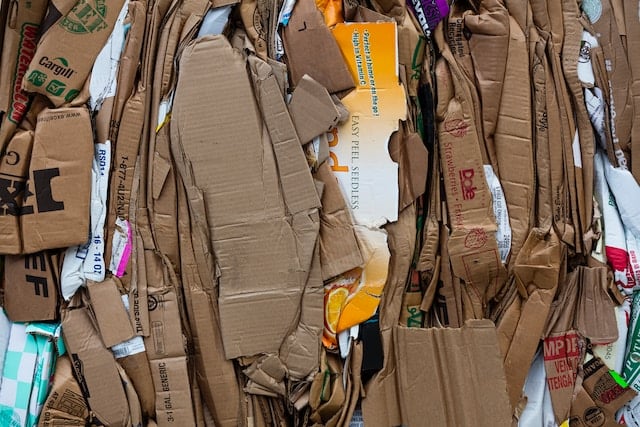Introduction – Composting Shredded Paper
Composting is a natural process that transforms organic waste into nutrient-rich soil amendments, offering numerous benefits for carbon reduction and sustainability. In our quest to find alternative ways to recycle paper products, composting shredded paper presents an eco-friendly solution. This article delves into the potential of using shredded paper in composting systems, discussing its advantages, limitations, and practical tips for implementation, all within the context of carbon reduction and sustainability.

Background On Paper Waste – Comprises Staggering 23% Of Household Waste
Data from the U.S. Environmental Protection Agency (EPA) provides critical insights. Utilizing statistics from the American Forest & Paper Association (AF&PA), the EPA estimated that the total generation of paper and paperboard in Municipal Solid Waste (MSW) was a staggering 67.4 million tons in 2018.
This amounted to 23.1% of the total MSW generated that year, making paper and paperboard waste a significant portion of overall waste. Despite this considerable figure, the silver lining was found in the recycling efforts, where approximately 46 million tons of paper and paperboard were recycled in 2018.
This represents a recycling rate of 68.2%, the highest rate compared to other materials in MSW. These statistics highlight the magnitude of paper-related waste, but also underscore the potential of recycling efforts in managing this environmental challenge.
Paper products are an essential part of modern life, with global consumption rates on the rise. The environmental impact of paper production and disposal is significant, involving deforestation, water pollution, and greenhouse gas emissions. Recycling and reducing paper waste are vital steps towards mitigating these negative effects and promoting a more sustainable future.
Shredded Paper As A Compostable Material
Many types of paper can be composted, including newspapers, office paper, and non-glossy cardboard. Composting shredded paper offers several benefits, such as reducing waste in landfills, enhancing soil quality, and sequestering carbon. Be mindful of potential limitations and drawbacks, such as the presence of inks or chemicals in certain paper types. Ensuring a proper balance of carbon and nitrogen materials in your compost pile is also crucial for success.
How To Incorporate Shredded Paper Into A Composting System
To prepare shredded paper for composting, first, ensure that it is free from plastic coatings, adhesives, and other contaminants. Next, maintain a healthy balance of green (nitrogen-rich) and brown (carbon-rich) materials in your compost pile. Green materials include fruit and vegetable scraps, coffee grounds, and grass clippings, while brown materials encompass leaves, straw, and shredded paper.
Adding shredded paper to your compost pile should be done in moderation to avoid creating an imbalance that might slow down the composting process. Regularly turn and mix your compost pile to promote aeration and ensure the even distribution of shredded paper throughout the pile.
Useful Equipment For Composting Paper
There are a few basic tools and supplies that can make the composting process more efficient and manageable:
- Compost bin or pile: A designated area or container for composting, ranging from a simple pile in your backyard to a commercially available compost bin or tumbler. Can take shredded paper or card board and food containers like broken up pizza boxes which are unevenly accepted by recycling centers due to the food and oil contamination.
- Shredder: A paper shredder can help you break down paper materials into smaller pieces, making them easier to compost and speeding up the decomposition process.
- Compost aerator or pitchfork: Regularly turning and mixing your compost pile promotes aeration, ensuring an even distribution of materials and facilitating decomposition. A compost aerator or pitchfork can be used for this purpose.
- Gloves and a garden fork (optional): Wearing gloves can protect your hands when handling compost materials, and a garden fork can be useful for adding or removing compost from your pile or bin.
- Thermometer (optional): Monitoring the temperature of your compost pile can help you assess the progress of decomposition and determine when to turn the pile. A compost thermometer can provide accurate temperature readings.
These tools and supplies are not strictly necessary, but they can help streamline the composting process and make it more effective.

Recycling Is Better Than Composting For Paper
Both composting and recycling paper contribute to carbon reduction, but they serve different purposes and have distinct benefits. Determining which method is better depends on the specific context and goals.
Composting paper:
- Contributes to the reduction of organic waste in landfills, which in turn decreases methane emissions.
- Enriches soil by adding organic matter and nutrients, promoting plant growth and reducing the need for synthetic fertilizers.
- Sequesters carbon in the soil, which helps mitigate climate change.
- May be more suitable for soiled or contaminated paper, which cannot be recycled.
Recycling paper:
- Reduces the demand for virgin pulp from trees, thus decreasing deforestation and associated carbon emissions.
- Saves energy and water compared to producing new paper from virgin materials.
- Reduces the volume of paper waste that goes to landfills, leading to lower methane emissions.
- Can be used for a wide range of paper products, including newspapers, office paper, and cardboard.
In general, recycling paper is often considered more beneficial for carbon reduction, as it reduces the need for new paper production, which has a more substantial environmental impact. However, composting paper can still be a valuable option, especially for soiled or contaminated paper that cannot be recycled or when recycling facilities are not available. The best approach may involve a combination of both composting and recycling to maximize the environmental benefits and promote a more sustainable paper lifecycle.
Conclusion – Composting Shredded Paper
In summary, composting shredded paper offers significant benefits for carbon reduction and sustainability. By considering the types of paper suitable for composting, addressing potential limitations, and following practical tips for implementation, individuals and communities can effectively incorporate shredded paper into their waste management strategies. As we continue to explore and research sustainable waste management practices, composting shredded paper stands as a promising solution for reducing our environmental footprint and fostering a greener future.
